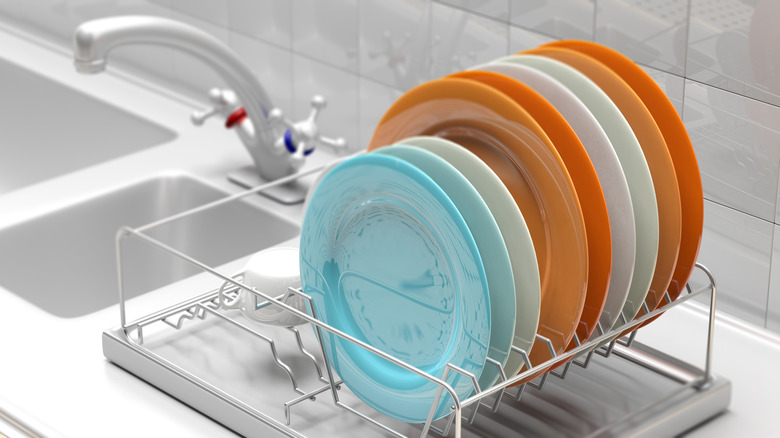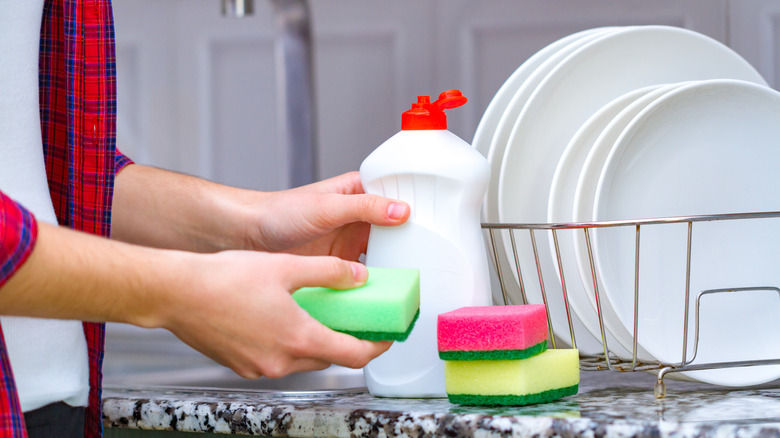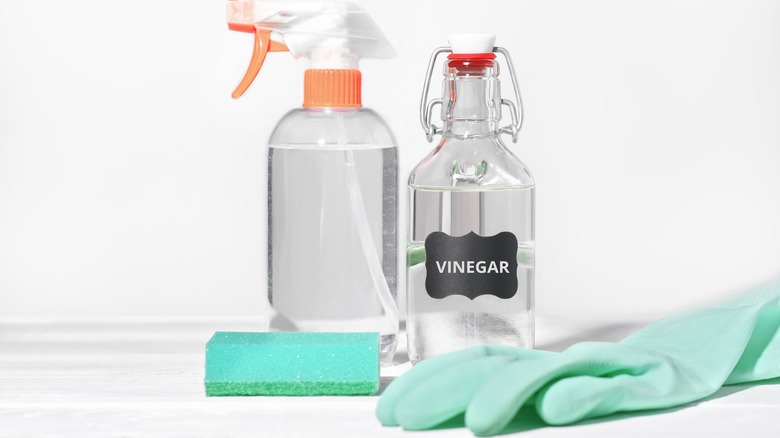How Often You Should Clean Your Dish Drying Rack (And The Grossest Spot To Hit)
Considering the amount of time it takes to wash your dishes every day, you might be forgetting to clean your dish drying rack too. Though it probably seems like this helpful kitchen accessory doesn't need to be washed often because it's only used to hold clean dishes, it's likely much dirtier than you realize. The small container piece of the drying rack that holds flatware often becomes a hidden breeding ground for mold, as water can pool in the bottom and doesn't ever dry out. This is why you'll need to quickly wash your dish drying rack every time you empty it or after a couple of days of use at most.
This can help to keep mold and mildew at bay, ensuring your dishes and your kitchen are as clean as possible. While you can simply wash your drying rack with hot water and soap or maybe even throw it in the dishwasher, depending on the material, you should fully sanitize it from time to time too. As you cook grease splatters and bacteria could end up on your dish drainer. Fortunately, vinegar and hydrogen peroxide can both be used to disinfect your rack, again, depending on what it's made from. Suffice it to say, though, if you're not cleaning your drying rack, your dishes aren't as clean as you think.
How to clean your dish drying rack
It might seem frivolous to wash your dish drying rack every time you put the dishes away, but this will allow you to ensure that it fully dries, preventing mold from growing. As Vera Peterson, the President of Molly Maid, a Neighborly company, told MarthaStewart.com, "Once you put the dishes away, be sure to wipe it down and dry it off with a clean towel. This will keep away mold and mildew and is a good preventative measure."
Additionally, germs from your hands or your kitchen can easily end up on your drainer and transfer to your clean dishes. For those who can't find the time to give it a quick wash every day, try to clean the rack every few days or once a week, depending on how often you wash dishes by hand. If you have a plastic or metal drying rack, you may be able to throw it in the dishwasher, which would not only help to clean it but sanitize it as well.
Cleaning your drying rack in the sink is also a good choice, of course. Simply take apart the drying rack if necessary, as much as you can, and wash it with soap and hot water, making sure to get into those gross cracks and crevices like the silverware compartment. Afterward, towel dry the rack so that no water is trapped. With wooden drainers, you should wipe them down with a rag dampened with soap and water rather than soaking them.
Disinfecting your dish drying rack
Washing your dish drying rack in your dishwasher will help to kill any germs that could be present, but you can also try vinegar, a versatile cleaning tool, for a deeper clean. Vinegar acts as a mild disinfectant because of the acetic acid it contains, which is why it's a great option for your drying rack. Simply pour white vinegar over the rack and leave it to dry, or soak it in a vinegar and hot water solution if your rack is especially grotty. Add one cup of vinegar to a sink full of water and let the completely covered rack sit in it for at least 15 minutes. Ideally, this should be done twice a week.
For those with dish drying racks made of wood, it may be best to use hydrogen peroxide as your disinfectant instead. Pour some standard 3% hydrogen peroxide solution into a spray bottle and mist it over the rack. Since hydrogen peroxide can have bleaching properties alongside being a disinfectant, try it on a small spot first to ensure it doesn't affect the color of the wood. It may require some elbow grease but, by regularly cleaning your dish drying rack and ensuring you hit the grossest spot — the silverware compartment — you won't have to worry about mold or germs touching your clean plates.


